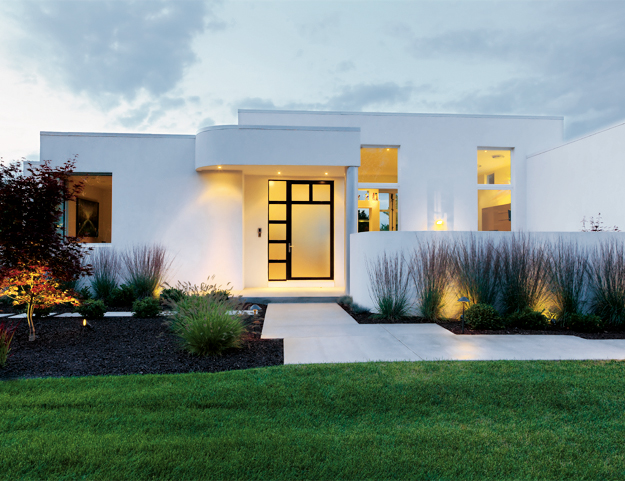
“The beauty of art is getting to know the story behind the art and the artist,” Bruce Loch says. The same can be said of this home and its owners.
With their daughter now a married mom living in London, Bruce and Pam Loch of Allentown set out to downsize their previous living space—like many couples at this stage of life do. They were concerned, however. Would it be possible to move from a 5,200 square-foot house to another offering about half the space?
Creating the Ideal
It was clear, though, that living in the big house was no longer practical. Actually, they were really only living in part of the house—and not having large parties like in years past, not watching movies in the theater room and not using the in-ground pool.
Bruce leads the Loch, Elsenbaumer, Newton & Co. accounting and consulting firm based in Allentown, and Pam is a homemaker and retired social worker. Their entertaining style had definitely changed. “Now we might have people over for drinks before we go out to a restaurant for dinner,” Pam explains, “or have a few couples over for dinner.”
Bruce says, “It was time for a new family to make great memories in that house. For us, at this time in our lives, it was way too much space,” he explains. “The ideal square footage for a couple like us is 2,000 to 2,500 square feet.”
Their primary consideration when moving was simple: How would their vast collection of art work in a smaller home?
Well, take a step inside their now one-story modern home and it is easy to see their vision was achieved. Art fills the home with saturated color and brilliant design.
“The layout of this house is great for us, everything is close,” Bruce says.
The white stucco one-story modern house stands out on a street of traditional two-story homes. With its high ceilings and large windows, the house feels roomy, but it's also cozy and welcoming.
On the first floor, there's an open kitchen-dining area-living room, Bruce's office and a spacious master bedroom and bath. On the other side of the kitchen there's a laundry room and a TV/family room. A spacious guest suite, complete with large sitting room—where Pam has office space—a storage closet and a bathroom, is located downstairs in the basement.
Once the decision was made to downsize, Pam found the lot and picked out the floor plan in December 2012. They were familiar with local architect Larry Berman's work and contracted him to do the design of the house.
“Randy Hoffman (owner of the local company, R&S Hoffman Builders), who also built our first house in 1988, built this house as well,” Bruce says.
Pam also worked with Berman on the interior—cabinets, hardware, everything. He came up with the paint colors and the tile floor coverings and colors, all subject to Pam's approval. The wall colors are shades of white and grey, with similar tones in the flooring, providing a neutral backdrop for the colorful art.
Yes, the art! Oil paintings, three-dimensional pieces and metal and glass sculptures of differing styles and movements all coexist harmoniously in this home. Many bright glassware pieces reside on a ledge over the expansive patio doors. The ledge was conceived and designed by Berman to showcase the glass.
“Those are the first items we collected,” Bruce says. Latchezar Boyadjiev of California created the contemporary glass sculptures. “All of the glass art was acquired prior to designing this house, except for the site-specific light painting in the kitchen,” Bruce says.

A Little Help from Their Friends
The largest painting in the living room is a triptych, New Generations, by the surrealist Ferjo (Fernando de Jesus Oliviera) from Brazil, who graduated from the Philadelphia Academy of Fine Arts in 1979. He lived in Philadelphia and had a studio in New York City for many years before moving to Florida.
“Fourteen years ago, we saw his work at a New York City art dealer,” Bruce says. “We started collecting his work and eventually became friends with him.
The panels that comprise New Generations are each 150 inches by 90 inches. In their previous home, there was plenty of wall space to hang the triptych flat, but not in this new house.
“Larry came up with the idea of hanging two panels on one wall with the third in the corner of the adjacent wall, and had them reframed to fit the space,” Bruce says. “I didn't think it would work, but Larry was right.”
More Ferjo paintings line the walls of Bruce's office. One called, Journey to the Past hangs across from his desk. He wanted another one for the adjacent wall, so they asked Ferjo to base a new piece on a vision of the future and the Broadway show How to Succeed in Business without Really Trying. Journey to the Future was born.
At first glance from across the room, the painting in the dining room looks like a flat matted and framed painting. However, as you walk diagonally toward Hoppera, you appear to be viewing it in 3-D. But it is only when you stand in front of it that you see it is actually a three-dimensional painted sculpture by Patrick Hughes.
The glass and stainless steel light sculpture in the kitchen is a redesign of another commissioned piece that was in their former home. Fandango III was redesigned by the artist, Stephen Knapp, to fit the area available in the new house. The 26 pieces of glass are placed so that each reflects light off of another piece. As the natural light changes throughout the day, the reflections vary, causing the light painting to transform as well.

Backstories
The other painting in the kitchen is also a remake of sorts. Bruce and Pam had—and loved—a large abstract expressionist painting in their old house. Again, it didn't fit any wall in their new home. When Bruce and Pam went back to Santa Fe, where the artist Javier Lopez Barbosa lived, they asked him to paint a new piece similar in color, line and style to the other one, but in a size that would fit the new kitchen.
As there are stories behind the art, there's also a story behind the kitchen itself. The kitchen was built in Germany but was shipped too early for the installation timeline. So back to the warehouse it went—where the flooding from Hurricane Sandy destroyed it. A new kitchen had to be ordered, built and shipped. Of course, they had to wait for it. But since they had to close on the sale of the old house, Bruce and Pam had to live in the guest suite downstairs for about a month until the upstairs was finished.
Other art in the home includes some portraits by Donald Roller Wilson—but these are no ordinary portraits. “Roller,” as he is known, is an American artist who paints in oils in highly detailed realism using the same techniques of the old masters. But his subjects are dogs, cats and chimpanzees dressed up in antique costumes and the result is quite whimsical.
Another favorite artist is Mark Kostabi, an American artist and composer. One of his paintings, They Have Everything at Tiffany's, depicts a woman carrying a Tiffany-blue bag holding a little businessman complete with briefcase. Kostabi produces a weekly cable TV show, The Kostabi Show (also known as Name That Painting), where art critics and celebrities compete to title his paintings. Contestants have included Suzanne Vega, Bela Fleck, the late Tommy Ramone, Sylvia Miles—and Bruce Loch! With Pam in the audience, of course.
Local artists are represented by the likes of Barnaby Ruhe, who painted an abstract portrait of Bruce and Pam at an event at the eDavid Gallery on Main Street in Bethlehem in 2007.
To protect the art that is not displayed, the Lochs asked Hoffman to build a finished plywood storage unit for the basement.
“Oil paintings are pretty resilient,” he explains. “As long as the temperature remains above 55 degrees and the humidity above 40 percent, the paintings will be fine. Prints will be protected as well as long as they are matted, mounted and framed.” The room that contains the storage unit also houses the gas furnace unit for the home, so the temperature never goes below 60 degrees.
Outside, there are some prized pieces of sculpture. In the front courtyard, Reflections by Allan Houser is featured prominently. It was shown at the Smithsonian in 2004, the year before the Lochs purchased it from the Houser Estate in Santa Fe.

The stainless steel sculpture in the backyard is titled Being Born by the sculptor Virginio Ferraro.
“Pam and I were going to an art show in Chicago in the fall of 2001, when I saw this beautiful stainless steel sculpture in a park as we entered the city,” Bruce remembers. “I said to Pam, I wonder if we could have someone make a sculpture for us if we take a photo of the piece. She told me I was crazy!”
They went on to their hotel and later to the art show at Chicago's famous Navy Pier. They were each wandering around the show, when Pam found Bruce and said, “‘You need to come with me,'” Bruce says. “Lo and behold, the maquette for the original sculpture was for sale, and that is what we have in our back yard.” (A maquette is a small-scale model or rough draft of an unfinished sculpture.)
They also have a sculpture in the backyard by Ronald Mehlman that they first saw at the Grounds for Sculpture garden in New Jersey.
“We've had a great time collecting art,” Bruce says. He is now an art dealer and director of Thurston Royce Gallery of Fine Art in Allentown.
“He can't do anything without making a business out of it,” Pam says with a laugh.
Smart move—in the art world the markup can be as much as 100 percent. So now they save money and collect even more of the art they love while meeting the artists and hearing the stories behind the paintings and sculptures.
The Lochs collect art from all over the country, but here at home, Bruce is on the board of the Lehigh Valley Arts Council (LVAC), working
to make arts available to individuals with disabilities. LVAC is collaborating with the Lehigh Valley Partnership for a Disability Friendly Community on Arts & Access, a yearlong celebration marking the 25th anniversary of the Americans with Disabilities Act through the arts so that everyone has a chance to learn the story behind the art.





















